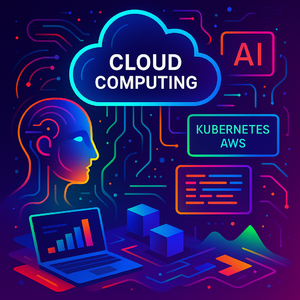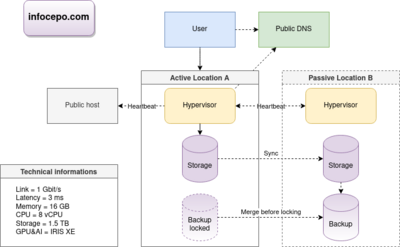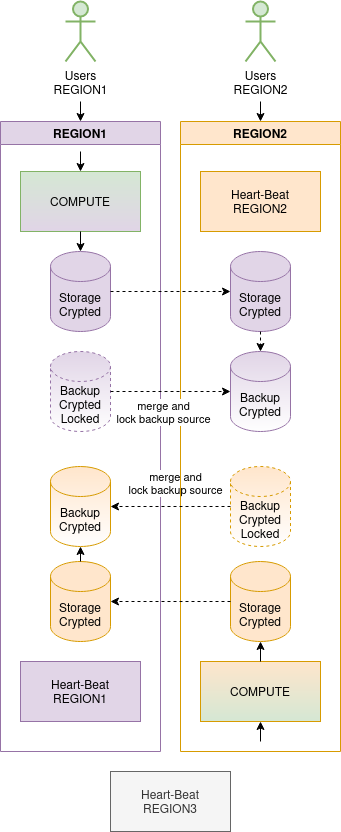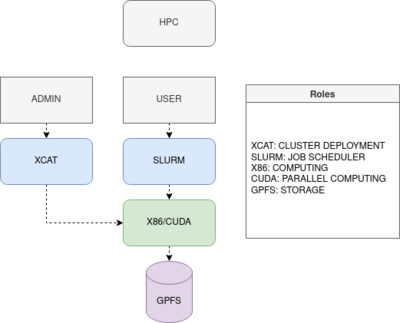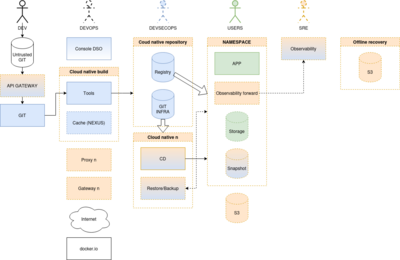Main Page: Difference between revisions
Jump to navigation
Jump to search
No edit summary |
|||
| (286 intermediate revisions by the same user not shown) | |||
| Line 1: | Line 1: | ||
[[File:Infocepo-picture.png|thumb|right|Discover cloud computing on infocepo.com]] | |||
= | = Discover Cloud Computing on infocepo.com = | ||
Welcome! This portal is designed for IT professionals, engineers, students, and enthusiasts who want to master cloud infrastructure, explore AI tools, and accelerate their IT skills through hands-on labs and open-source solutions. | |||
__TOC__ | |||
* | == Quick Start == | ||
* '''Master cloud infrastructure:''' Practical guides and labs | |||
* '''Explore artificial intelligence:''' Trends and hands-on tools | |||
* '''Compare cloud providers:''' Kubernetes, AWS, OpenStack, and more | |||
* '''Develop expertise:''' Training, open-source, and real-world projects | |||
---- | |||
*. | = AI & Cloud Tools = | ||
; '''AI Assistants''' | |||
* [https://chat.openai.com ChatGPT] – Public conversational AI with strong learning capabilities | |||
* [https://github.com/open-webui/open-webui Open WebUI] + [https://www.scaleway.com/en/h100-pcie-try-it-now/ GPU H100] + [https://ollama.com Ollama] – Private assistants and self-hosted LLM APIs | |||
| | * [https://github.com/ynotopec/summarize Private summary] – Fast, offline summarizer for your data | ||
; '''Development & Model Tracking''' | |||
* [https://ollama.com/library LLM Trending] – Latest open-source LLMs | |||
* [https://github.com/search?q=stars%3A%3E15000+forks%3A%3E1500+created%3A%3E2022-06-01&type=repositories&s=updated&o=desc Project Trending] – Top trending codebases since 2022 | |||
* [https://lmarena.ai/leaderboard ChatBot Evaluation] – Compare chatbot performance | |||
* [https://www.perplexity.ai Perplexity AI] – Cutting-edge research and question answering | |||
* [https://huggingface.co/models Models Trending] – Model marketplace | |||
* [https://github.com/hiyouga/LLaMA-Factory LLM Fine Tuning] – Advanced training framework | |||
* [https://huggingface.co/spaces/mteb/leaderboard Embedding Leaderboard] – Ranking for vector search models | |||
* [https://ann-benchmarks.com Vectors DB Ranking] – Database speed and feature comparison | |||
* [https://www.nvidia.com/en-us/data-center/h100/ NVIDIA H100] – HPC/AI GPUs for Kubernetes clusters | |||
* NVIDIA 5080 – Consumer GPU for private deployments | |||
* [https://huggingface.co/models?pipeline_tag=image-text-to-text&sort=trending Img2txt Trending] – Vision-language models | |||
* [https://huggingface.co/spaces/TIGER-Lab/GenAI-Arena Txt2img Evaluation] – Compare generative image models | |||
* [https://top500.org/lists/green500/ HPC Efficiency] – Top green supercomputers | |||
---- | |||
== Notable Open LLMs == | |||
''(Last updated: 26/07/2025)'' | |||
{| class="wikitable" | |||
! Model !! Description / Notable Features | |||
|- | |- | ||
| | | '''ai-chat''' || gemma3n, cost efficient | ||
|- | |- | ||
| | | '''ai-translate''' || gemma3n, temperature=0 (deterministic translation) | ||
|- | |- | ||
| | | '''ai-summary''' || qwen2.5, optimized for summarization | ||
| | |||
|- | |- | ||
| '''ai-code''' || mistral-small, advanced code reasoning | |||
|- | |||
| '''ai-code-completion''' || granite-2b, fast code suggestions | |||
|- | |||
| '''ai-parse''' || gemma2-simpo, parsing & extraction | |||
|- | |||
| '''ai-RAG-FR''' || qwen2.5, French RAG applications | |||
|- | |||
| '''mannix/gemma2-9b-simpo''' || OllamaFunctions integration | |||
|} | |} | ||
* | ---- | ||
= Industry News & Trends = | |||
* [https://www.youtube.com/@lev-selector/videos Top AI News] – Video digest | |||
* [https://betterprogramming.pub/color-your-captions-streamlining-live-transcriptions-with-diart-and-openais-whisper-6203350234ef Real-time transcription with Diart + Whisper] – Speaker tracking | |||
* [https://github.com/openai-translator/openai-translator OpenAI Translator] – Modern open-source translation | |||
* [https://www.mouser.fr/ProductDetail/BittWare/RS-GQ-GC1-0109?qs=ST9lo4GX8V2eGrFMeVQmFw%3D%3D GROQ LLM accelerator] – Fast, low-cost inference hardware | |||
* [https://opensearch.org/docs/latest/search-plugins/conversational-search Opensearch with LLM] – Enhanced search experiences | |||
---- | |||
= Training & Learning = | |||
* [https://www.youtube.com/watch?v=4Bdc55j80l8 Transformers Explained] – Intro to Transformers algorithm | |||
* Hands-on labs and scripts in the [[LAB project|CLOUD LAB]] below | |||
---- | |||
= Cloud Lab & Audit Projects = | |||
[[File:Infocepo.drawio.png|400px|Cloud Lab Reference Diagram]] | |||
; '''Lab Project''' | |||
Experiment with high-availability, cloud migration, and audit automation. | |||
*. | === Cloud Audit === | ||
* '''[[ServerDiff.sh]]''' – Bash script for auditing servers, tracking config drift, and checking environment consistency | |||
=== Cloud Migration Example === | |||
[[File:Diagram-migration-ORACLE-KVM-v2.drawio.png|400px|Cloud Migration Diagram]] | |||
{| class="wikitable" | |||
! Task !! Description !! Duration (days) | |||
|- | |||
| Audit infrastructure || 82 services, automated via ServerDiff.sh || 1.5 | |||
|- | |||
| Diagram cloud architecture || Visual design || 1.5 | |||
|- | |||
| Compliance check || 2 clouds, 6 hypervisors, 6TB RAM || 1.5 | |||
|- | |||
| Install cloud platforms || Deploy core cloud environments || 1.0 | |||
|- | |||
| Stability check || Early operations || 0.5 | |||
|- | |||
| Automation study || Automate deployment/tasks || 1.5 | |||
|- | |||
| Develop templates || 6 templates, 8 envs, 2 clouds/OS || 1.5 | |||
|- | |||
| Migration diagram || Process illustration || 1.0 | |||
|- | |||
| Write migration code || 138 lines (see MigrationApp.sh) || 1.5 | |||
|- | |||
| Process stabilization || Ensure repeatable migration || 1.5 | |||
|- | |||
| Cloud benchmarking || Performance test vs legacy || 1.5 | |||
|- | |||
| Downtime calibration || Per-migration time calculation || 0.5 | |||
|- | |||
| VM loading || 82 VMs: OS, code, 2 IPs each || 0.1 | |||
|- | |||
! colspan=2 align="right"| '''Total''' !! 15 man-days | |||
|} | |||
== | ==== Stability check ==== | ||
{| class="wikitable" | {| class="wikitable" | ||
! Action !! Expected Result | |||
|- | |- | ||
| | | Power off one node || All resources started | ||
| | |||
| | |||
|- | |- | ||
| | | Power off/on all nodes simultaneously || All resources started | ||
| | |} | ||
| | |||
---- | |||
= Web Infrastructure & Best Practices = | |||
| | |||
[[File:WebModelDiagram.drawio.png|400px|Web Architecture Reference]] | |||
* Favor minimal, flexible infrastructure | |||
* Track customer location via GDNS or similar | |||
* Use network load balancers (LVS, IPVS) for scaling | |||
* Compare prices and beware of vendor lock-in | |||
* For TLS: use HAProxy for fast frontend, Envoy for compatibility | |||
* Caching: Varnish, Apache Traffic Server for large content | |||
* Prefer open-source stacks and database caches (e.g. Memcached) | |||
* Use message queues and buffers for workload smoothing | |||
* For more examples: [https://wikitech.wikimedia.org/wiki/Wikimedia_infrastructure Wikimedia Cloud Architecture], [https://github.com/systemdesign42/system-design System Design GitHub] | |||
---- | |||
= Major Cloud Platforms: Feature Comparison = | |||
{| class="wikitable" | |||
! Function !! Kubernetes !! OpenStack !! AWS !! Bare-metal !! HPC !! CRM !! oVirt | |||
|- | |- | ||
| | | '''Deployment Tools''' || Helm, YAML, ArgoCD, Juju || Ansible, Terraform, Juju || CloudFormation, Terraform, Juju || Ansible, Shell || xCAT, Clush || Ansible, Shell || Ansible, Python | ||
| | |||
| | |||
| | |||
| | |||
| | |||
| | |||
| | |||
|- | |- | ||
| | | '''Bootstrap Method''' || API || API, PXE || API || PXE, IPMI || PXE, IPMI || PXE, IPMI || PXE, API | ||
|API | |||
|API | |||
|API | |||
| | |||
| | |||
| | |||
|API | |||
|- | |- | ||
| | | '''Router Control''' || Kube-router || Router/Subnet API || Route Table/Subnet API || Linux, OVS || xCAT || Linux || API | ||
| | |||
| | |||
| | |||
| | |||
| | |||
| | |||
|API | |||
|- | |- | ||
| | | '''Firewall Control''' || Istio, NetworkPolicy || Security Groups API || Security Group API || Linux Firewall || Linux Firewall || Linux Firewall || API | ||
| | |||
|API | |||
|API | |||
| | |||
| | |||
| | |||
|API | |||
|- | |- | ||
| | | '''Network Virtualization''' || VLAN, VxLAN, others || VPC || VPC || OVS, Linux || xCAT || Linux || API | ||
| | |||
| | |||
| | |||
| | |||
| | |||
| | |||
| | |||
|- | |- | ||
| | | '''DNS''' || CoreDNS || DNS-Nameserver || Route 53 || GDNS || xCAT || Linux || API | ||
| | |||
| | |||
| | |||
|GDNS | |||
| | |||
| | |||
|API | |||
|- | |- | ||
|Load | | '''Load Balancer''' || Kube-proxy, LVS || LVS || Network Load Balancer || LVS || SLURM || Ldirectord || N/A | ||
| | |||
|LVS | |||
|Network Load Balancer | |||
|LVS | |||
|SLURM | |||
|Ldirectord | |||
| | |||
|- | |- | ||
|Storage | | '''Storage Options''' || Local, Cloud, PVC || Swift, Cinder, Nova || S3, EFS, EBS, FSx || Swift, XFS, EXT4, RAID10 || GPFS || SAN || NFS, SAN | ||
| | |||
| | |||
|S3 | |||
| | |||
|GPFS | |||
|SAN | |||
|NFS | |||
|} | |} | ||
== | ---- | ||
[https://landscape.cncf.io/?fullscreen=yes | |||
= Useful Cloud & IT Links = | |||
* [https://cloud.google.com/free/docs/aws-azure-gcp-service-comparison Cloud Providers Compared] | |||
* [https://global-internet-map-2021.telegeography.com/ Global Internet Topology Map] | |||
* [https://landscape.cncf.io/?fullscreen=yes CNCF Official Landscape] | |||
* [https://wikitech.wikimedia.org/wiki/Wikimedia_infrastructure Wikimedia Cloud Wiki] | |||
* [https://openapm.io OpenAPM – SRE Tools] | |||
* [https://access.redhat.com/downloads/content/package-browser RedHat Package Browser] | |||
* [https://www.silkhom.com/barometre-2021-des-tjm-dans-informatique-digital Freelance IT Rates] | |||
* [https://www.glassdoor.fr/salaire/Hays-Salaires-E10166.htm IT Salaries (Glassdoor)] | |||
---- | |||
= Advanced: High-Availability, HPC & DevSecOps = | |||
== | == High Availability with Corosync & Pacemaker == | ||
[[File:HA-REF.drawio.png|400px|HA Cluster Architecture]] | |||
* Multi-node or dual-room clusters for redundancy | |||
* | * Use IPMI for fencing, provision via PXE/NTP/DNS/TFTP | ||
* For 2-node clusters: stagger fencing for stability; 3+ nodes recommended | |||
* | |||
* | |||
=== Common Resources Pattern === | |||
* Multipath storage, LUN, LVM, NFS | |||
* User and process resources | |||
* IP, DNS, Listener management | |||
DNS | |||
== HPC == | |||
[[File:HPC.drawio.png|400px|HPC Cluster Overview]] | |||
== DevSecOps == | |||
[[File:DSO-POC-V3.drawio.png|400px|DevSecOps Reference Design]] | |||
---- | |||
'''For more examples, guides, and scripts, visit [https://infocepo.com infocepo.com]. Contributions and suggestions welcome!''' | |||
Latest revision as of 19:13, 7 October 2025
Discover Cloud Computing on infocepo.com
Welcome! This portal is designed for IT professionals, engineers, students, and enthusiasts who want to master cloud infrastructure, explore AI tools, and accelerate their IT skills through hands-on labs and open-source solutions.
Quick Start
- Master cloud infrastructure: Practical guides and labs
- Explore artificial intelligence: Trends and hands-on tools
- Compare cloud providers: Kubernetes, AWS, OpenStack, and more
- Develop expertise: Training, open-source, and real-world projects
AI & Cloud Tools
- AI Assistants
- ChatGPT – Public conversational AI with strong learning capabilities
- Open WebUI + GPU H100 + Ollama – Private assistants and self-hosted LLM APIs
- Private summary – Fast, offline summarizer for your data
- Development & Model Tracking
- LLM Trending – Latest open-source LLMs
- Project Trending – Top trending codebases since 2022
- ChatBot Evaluation – Compare chatbot performance
- Perplexity AI – Cutting-edge research and question answering
- Models Trending – Model marketplace
- LLM Fine Tuning – Advanced training framework
- Embedding Leaderboard – Ranking for vector search models
- Vectors DB Ranking – Database speed and feature comparison
- NVIDIA H100 – HPC/AI GPUs for Kubernetes clusters
- NVIDIA 5080 – Consumer GPU for private deployments
- Img2txt Trending – Vision-language models
- Txt2img Evaluation – Compare generative image models
- HPC Efficiency – Top green supercomputers
Notable Open LLMs
(Last updated: 26/07/2025)
| Model | Description / Notable Features |
|---|---|
| ai-chat | gemma3n, cost efficient |
| ai-translate | gemma3n, temperature=0 (deterministic translation) |
| ai-summary | qwen2.5, optimized for summarization |
| ai-code | mistral-small, advanced code reasoning |
| ai-code-completion | granite-2b, fast code suggestions |
| ai-parse | gemma2-simpo, parsing & extraction |
| ai-RAG-FR | qwen2.5, French RAG applications |
| mannix/gemma2-9b-simpo | OllamaFunctions integration |
Industry News & Trends
- Top AI News – Video digest
- Real-time transcription with Diart + Whisper – Speaker tracking
- OpenAI Translator – Modern open-source translation
- GROQ LLM accelerator – Fast, low-cost inference hardware
- Opensearch with LLM – Enhanced search experiences
Training & Learning
- Transformers Explained – Intro to Transformers algorithm
- Hands-on labs and scripts in the CLOUD LAB below
Cloud Lab & Audit Projects
- Lab Project
Experiment with high-availability, cloud migration, and audit automation.
Cloud Audit
- ServerDiff.sh – Bash script for auditing servers, tracking config drift, and checking environment consistency
Cloud Migration Example
| Task | Description | Duration (days) |
|---|---|---|
| Audit infrastructure | 82 services, automated via ServerDiff.sh | 1.5 |
| Diagram cloud architecture | Visual design | 1.5 |
| Compliance check | 2 clouds, 6 hypervisors, 6TB RAM | 1.5 |
| Install cloud platforms | Deploy core cloud environments | 1.0 |
| Stability check | Early operations | 0.5 |
| Automation study | Automate deployment/tasks | 1.5 |
| Develop templates | 6 templates, 8 envs, 2 clouds/OS | 1.5 |
| Migration diagram | Process illustration | 1.0 |
| Write migration code | 138 lines (see MigrationApp.sh) | 1.5 |
| Process stabilization | Ensure repeatable migration | 1.5 |
| Cloud benchmarking | Performance test vs legacy | 1.5 |
| Downtime calibration | Per-migration time calculation | 0.5 |
| VM loading | 82 VMs: OS, code, 2 IPs each | 0.1 |
| Total | 15 man-days | |
Stability check
| Action | Expected Result |
|---|---|
| Power off one node | All resources started |
| Power off/on all nodes simultaneously | All resources started |
Web Infrastructure & Best Practices
- Favor minimal, flexible infrastructure
- Track customer location via GDNS or similar
- Use network load balancers (LVS, IPVS) for scaling
- Compare prices and beware of vendor lock-in
- For TLS: use HAProxy for fast frontend, Envoy for compatibility
- Caching: Varnish, Apache Traffic Server for large content
- Prefer open-source stacks and database caches (e.g. Memcached)
- Use message queues and buffers for workload smoothing
- For more examples: Wikimedia Cloud Architecture, System Design GitHub
Major Cloud Platforms: Feature Comparison
| Function | Kubernetes | OpenStack | AWS | Bare-metal | HPC | CRM | oVirt |
|---|---|---|---|---|---|---|---|
| Deployment Tools | Helm, YAML, ArgoCD, Juju | Ansible, Terraform, Juju | CloudFormation, Terraform, Juju | Ansible, Shell | xCAT, Clush | Ansible, Shell | Ansible, Python |
| Bootstrap Method | API | API, PXE | API | PXE, IPMI | PXE, IPMI | PXE, IPMI | PXE, API |
| Router Control | Kube-router | Router/Subnet API | Route Table/Subnet API | Linux, OVS | xCAT | Linux | API |
| Firewall Control | Istio, NetworkPolicy | Security Groups API | Security Group API | Linux Firewall | Linux Firewall | Linux Firewall | API |
| Network Virtualization | VLAN, VxLAN, others | VPC | VPC | OVS, Linux | xCAT | Linux | API |
| DNS | CoreDNS | DNS-Nameserver | Route 53 | GDNS | xCAT | Linux | API |
| Load Balancer | Kube-proxy, LVS | LVS | Network Load Balancer | LVS | SLURM | Ldirectord | N/A |
| Storage Options | Local, Cloud, PVC | Swift, Cinder, Nova | S3, EFS, EBS, FSx | Swift, XFS, EXT4, RAID10 | GPFS | SAN | NFS, SAN |
Useful Cloud & IT Links
- Cloud Providers Compared
- Global Internet Topology Map
- CNCF Official Landscape
- Wikimedia Cloud Wiki
- OpenAPM – SRE Tools
- RedHat Package Browser
- Freelance IT Rates
- IT Salaries (Glassdoor)
Advanced: High-Availability, HPC & DevSecOps
High Availability with Corosync & Pacemaker
- Multi-node or dual-room clusters for redundancy
- Use IPMI for fencing, provision via PXE/NTP/DNS/TFTP
- For 2-node clusters: stagger fencing for stability; 3+ nodes recommended
Common Resources Pattern
- Multipath storage, LUN, LVM, NFS
- User and process resources
- IP, DNS, Listener management
HPC
DevSecOps
For more examples, guides, and scripts, visit infocepo.com. Contributions and suggestions welcome!
